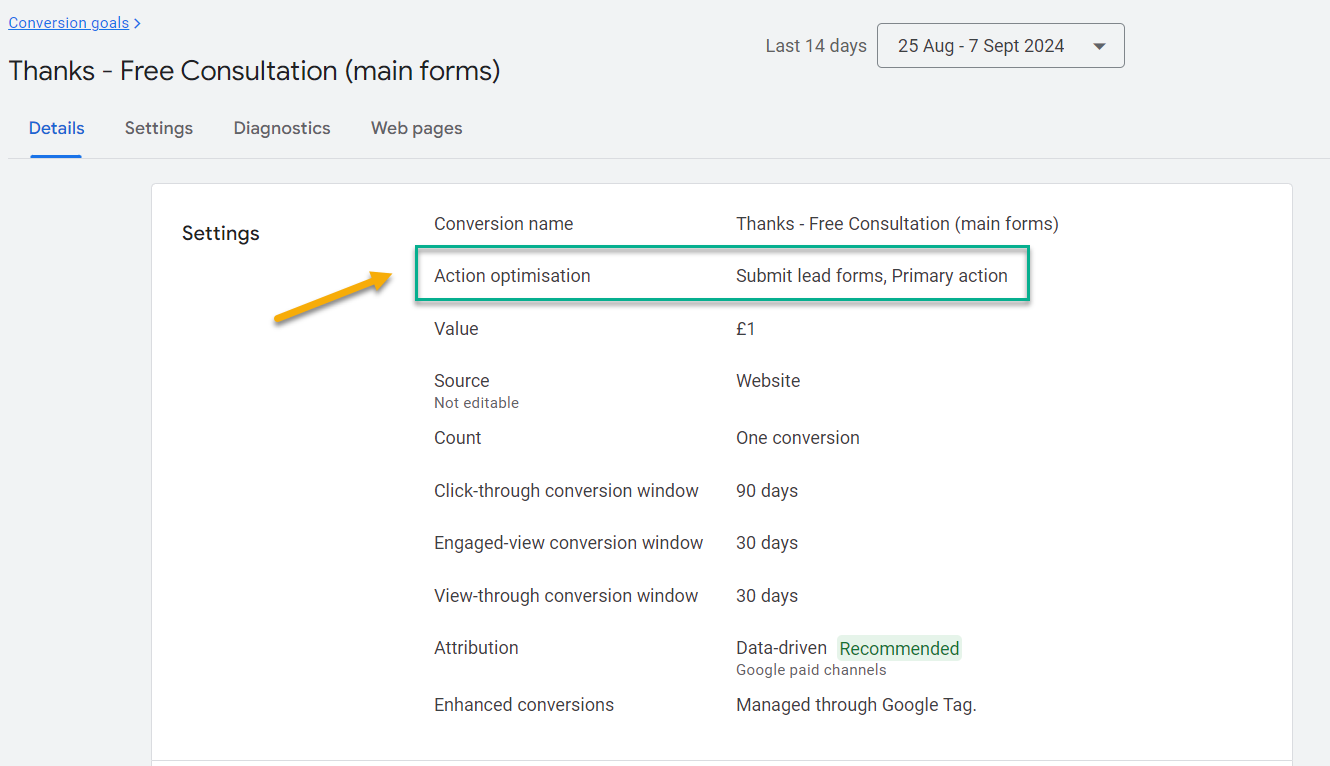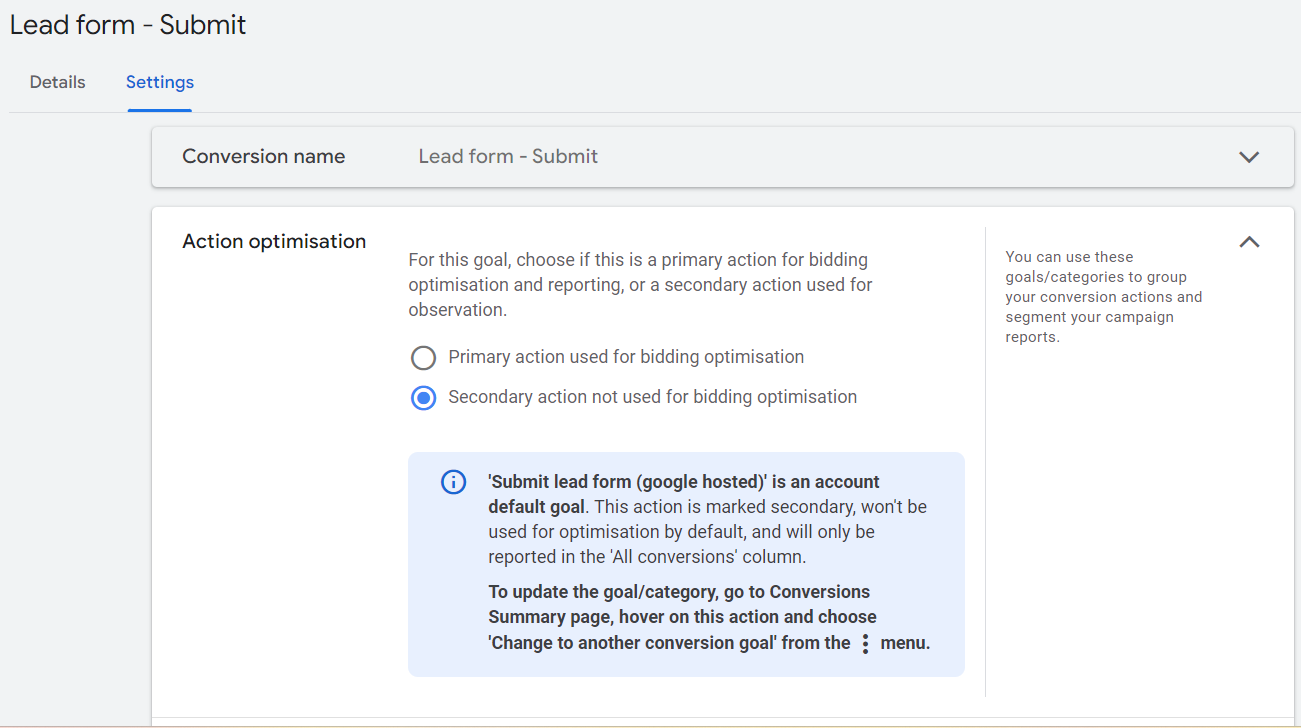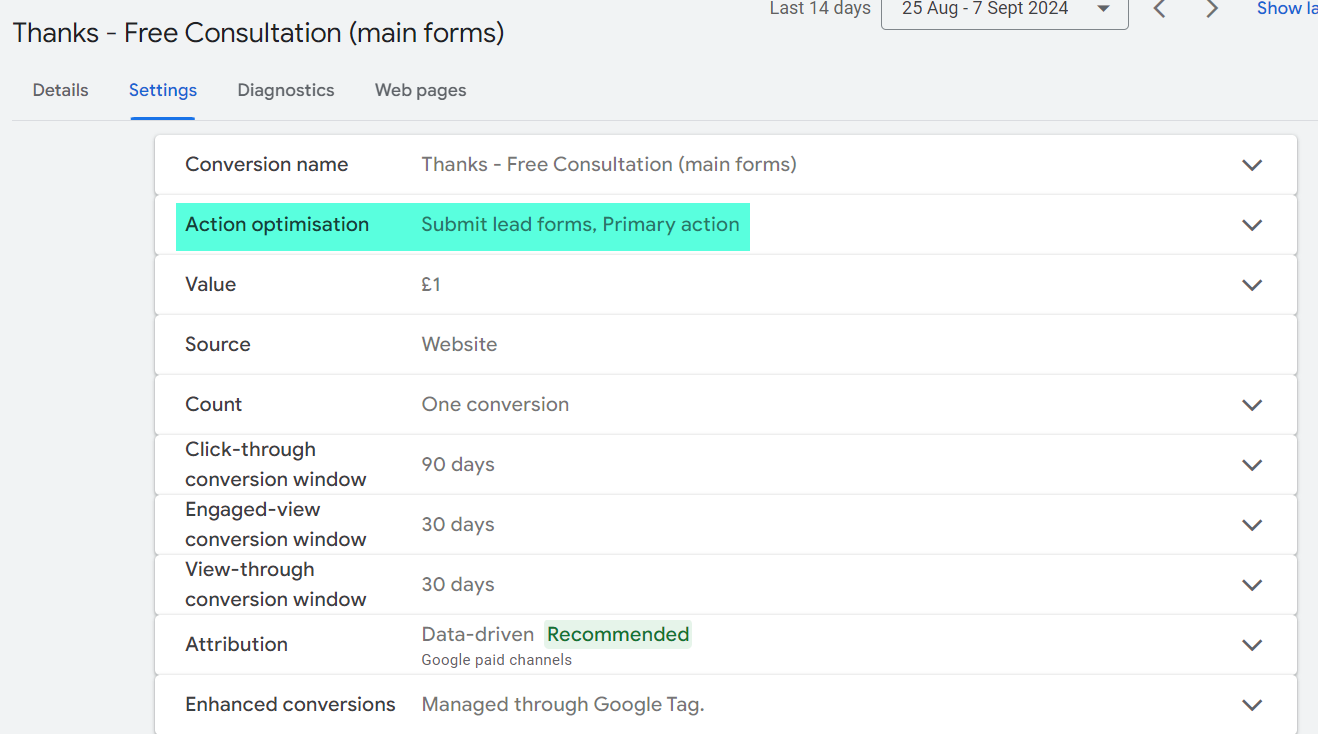To maximise the effectiveness of your Google Ads campaigns, it’s essential to understand and strategically employ both primary and secondary conversions. Primary conversions are direct indicators of campaign success, closely tied to your main business objectives like sales and lead generation. Secondary conversions, while not directly influencing bidding strategies, provide valuable insights into user behaviour and the broader customer journey, enriching your understanding of how interactions with your brand evolve.
By effectively tracking and analysing these conversion types, you can refine your advertising strategies, allocate your budget more efficiently, and enhance overall campaign performance. Embrace the nuances of primary and secondary conversions to ensure your Google Ads not only meet but exceed your marketing goals. If you need further assistance in optimising your conversion strategies or have any questions, our team of experts is always ready to help you navigate the complexities of Google Ads to achieve optimal results.

About Primary and Secondary Conversion Actions
In Google Ads, conversion actions that you desire your customers to undertake are categorised into conversion goals. For instance, the ‘Lead’ conversion goal encompasses all your conversion actions where prospects become a lead.
When setting up Google Ads conversion tracking, it’s crucial to select specific conversion actions for bidding optimisation and inclusion in standard reports. The key actions utilised for these purposes are known as primary conversion actions. Conversely, actions not directly employed for campaign optimisation are labelled secondary.
When establishing conversion tracking, you select primary and secondary conversion actions that support a defined goal:
- Primary actions are those reported in the ‘Conversions’ column in your reports and used for bidding, as long as the standard goal they are part of is employed for bidding.
- Secondary actions are observed only. They appear in the ‘All conversions’ column in your reports but are not used for bidding, except if the goal they are included in is used for bidding or if the secondary action is part of a custom goal.
Primary Conversions Explained
Primary Conversions represent the most important actions that align directly with your business goals. Primary conversions are vital because they directly impact your revenue and business growth. They represent the end goal of your marketing funnel and are the primary indicator of your campaign’s success.
Primary conversions are used by Google’s bidding algorithm as the actions to be optimised for. So if you are optimising for leads using Target CPA bidding, the algorithm will get as many possible primary conversions as possible. This could include complete lead forms, phone calls – or even sales. (e.g. cost per sale).
These are the main objectives you want to achieve through your Google Ads campaigns, such as:
- Purchase: If you run an e-commerce site, a sale is likely your primary conversion.
- Lead Generation: For service-based businesses, form submissions or calls from potential clients might be the key conversion.
- Sign-Ups: If your business operates on a subscription model, new sign-ups could be your primary conversion goal.
- Booking: For businesses like hotels or clinics, completed bookings are often the primary conversion.
Tracking Primary Conversions
Tracking Primary Conversions To track primary conversions effectively in Google Ads:
- Set Up Conversion Tracking: Implement Google Ads’ conversion tracking to monitor the actions most crucial to your business. Ensure your tracking code is correctly installed on the pages where these conversions occur.
- Optimise Bidding Strategies: Utilise Google Ads’ automated bidding strategies such as Target CPA (Cost Per Acquisition) or Target ROAS (Return on Ad Spend), aligning them with your primary conversions to maximise their occurrence.
- Analyse Performance: Regularly review the performance data of your primary conversions to gauge their impact on your overall business objectives and refine your campaigns accordingly.

Secondary Conversions Explained
Secondary Conversions are significant actions that, while not the primary goal, still provide valuable reporting insights into user behaviour. Secondary conversions offer a broader understanding of the customer journey. They are instrumental in deciphering the steps users undertake before completing a primary conversion and can signal potential future conversions, allowing for refined targeting and messaging.
These might include:
- Newsletter Sign-Ups: Indicative of user interest, these can be nurtured over time.
- Page Views: Monitoring visits to specific product pages helps understand user intent.
- Video Views: If promoting via video, tracking views gauges user engagement.
- Engagement Metrics: Downloads of whitepapers, eBooks, or other content that might lead to a future primary conversion.
Tracking Secondary Conversions
Tracking Secondary Conversions To track secondary conversions effectively in Google Ads:
- Create Custom Conversions: Set up custom conversions in Google Ads or Google Analytics to track secondary actions that align with your overall marketing strategy.
- Use Audience Lists: By monitoring secondary conversions, create targeted audience lists for remarketing, engaging users who have shown interest but haven’t yet completed a primary conversion.
- Segment Your Data: Analyse your secondary conversion data separately from your primary conversions to understand different user behaviours and identify patterns that could enhance campaign strategies.
How to Use Primary and Secondary Conversions Together Strategic Integration
Using primary and secondary conversions together allows you to create a more nuanced and effective marketing strategy. For example:
- Funnel Optimisation: By tracking secondary conversions, you can identify where users drop off in the funnel and take steps to guide them toward the primary conversion.
- Remarketing Campaigns: Use secondary conversion data to build highly targeted remarketing campaigns that push users towards completing a primary conversion.
- Budget Allocation: Allocate budget more effectively by understanding which secondary conversions lead to primary conversions, ensuring that your spend is driving the most value.

Google Machine Learning & Primary Actions
Machine learning in Google Ads has revolutionized how campaigns are optimised, moving from manual adjustments to automated, data-driven decision-making. This technology utilises historical conversion data to enhance Google Ads bidding strategies, predict user behaviours, and refine audience targeting effectively.
Accurate and comprehensive conversion tracking is now essential, as it feeds the machine learning algorithms the necessary data to optimize campaigns towards more valuable conversions. As these technologies evolve, the precision and depth of campaign insights and adjustments continue to deepen, underscoring the importance of a robust setup in conversion tracking.
The Evolution of Conversion Tracking: From Manual to Machine Learning
In the early stages of Google Ads, when management was predominantly manual, conversion tracking primarily functioned as a reporting tool. Advertisers relied on the data gathered from conversion tracking to make informed decisions about their campaigns. They manually reviewed conversion metrics to understand which aspects of their campaigns were effective and which needed adjustments. This method required meticulous attention to detail and a hands-on approach to campaign management, with advertisers regularly tweaking ad placements, keyword bids, and ad copy based on the conversion data they collected.
The Shift to Machine Learning
With the introduction of machine learning technologies in Google Ads, the role and importance of conversion tracking have significantly evolved. Now, the setup of your conversion tracking is more critical than ever because the optimization of your campaigns heavily relies on the data you provide. Machine learning algorithms use this data to make automated decisions about your ad campaigns in real-time.
Automated Bidding: Machine learning algorithms analyse past performance data and adjust bids automatically to maximise the likelihood of achieving conversions. The precision of these adjustments depends directly on the quality and completeness of your conversion tracking data.
Predictive Insights: Beyond just reacting to past data, machine learning in Google Ads predicts future user behaviour based on trends observed in your conversion tracking. This predictive capability allows for proactive campaign adjustments, targeting users more likely to convert based on a comprehensive analysis of historical conversion data.
Enhanced Targeting: Machine learning uses conversion tracking data to refine audience targeting, focusing your advertising spend on segments of users who are most likely to convert, thereby increasing campaign efficiency and ROI.
The Critical Importance of Accurate Conversion Tracking
Accurate conversion tracking is the backbone of effective machine-learning applications in Google Ads. The data collected not only informs the algorithms about which conversions are occurring but also provides the context necessary for understanding why these conversions happen. This allows the machine learning models to optimise not just for more conversions, but for more valuable conversions, aligning closely with your business objectives.
Data Integrity: Ensuring that your conversion tracking is set up correctly guarantees that the data fed into the machine learning algorithms is reliable. Incorrect or incomplete data can lead to suboptimal decision-making by the algorithms, potentially wasting ad spend on less effective campaign elements.
Comprehensive Tracking: It’s essential to track all types of conversions that matter to your business, whether they’re online purchases, phone calls, app downloads, or in-store visits. The more comprehensive your tracking, the more effectively machine learning can operate to optimize your campaigns across all user touchpoints.
Offline Conversion Tracking
The integration of Google Ads Offline Conversion Tracking with primary actions offers a robust approach to refining and targeting campaigns based on comprehensive conversion data. Offline Conversion Tracking is a potent enhancement for Google Ads campaigns, especially when linked with primary conversion actions.
It bridges the gap between online advertising and tangible business outcomes, providing a clear path to optimise campaigns for better lead quality and increased sales. By effectively implementing OCT, businesses can maximise the efficiency of their ad spend and drive significant improvements in overall performance.
Here’s how it enhances the optimisation of lead quality and increase sales:
Improved Lead Quality: By tracking which ads lead to high-value customer engagements offline, advertisers can fine-tune their campaigns targeting, ad creative and bidding strategies that yield higher-quality leads. For instance, if certain keywords or ad creatives consistently result in more lucrative in-person consultations or sign-ups, you can increase focus and bidding on those elements.
Sales Conversion Optimisation: OCT allows for a clearer understanding of how online interactions lead to offline sales. This insight is crucial for businesses that have a significant offline sales process, such as automotive dealerships or real estate agencies. Advertisers can adjust their online campaigns to support the types of interactions that are most likely to result in actual sales, based on historical data. Offline conversion tracking imports this revenue value to report on within Google Ads
ROI Measurement and Enhancement: By attributing offline conversions to specific campaigns, ads, or keywords, businesses can more accurately measure their return on investment. This measurement can lead to more informed decisions about budget allocations and bid strategies, focusing resources on the most effective tactics.
Holistic Customer Journey Analysis: Integrating offline conversions helps create a full picture of the customer journey. This comprehensive view enables marketers to understand how various touchpoints contribute to conversions and tailor their strategies accordingly.
Implementing Offline Conversion Tracking
To implement OCT, you need to:
- Enable Auto-tagging in Google Ads to ensure every ad click receives a unique identifier (GCLID or hashed emails).
- Capture and store the GCLID on your website, typically by incorporating it into form submissions or through cookies.
- Collect conversion data with the corresponding GCLID from your CRM or sales database.
- Enable enhanced conversion tracking to record both conversions for the web and leads.
- Upload this data back to Google Ads using the Google Ads API or manually through the Google Ads interface.
Reporting and Analysis
Google Ads allows you to customise your reporting to focus on both primary and secondary conversions. Use these reports to:
- Understand the Full Customer Journey: By analysing both conversion types, you can gain insights into the full customer journey, from initial interest to final purchase.
- Refine Targeting: Identify which secondary conversions are most predictive of primary conversions and refine your audience targeting based on this information.
- Optimise Ad Creatives: Use insights from secondary conversions to test and optimise ad creatives that resonate more with your audience, driving more primary conversions.
Conclusion
To maximise the effectiveness of your Google Ads campaigns, it’s essential to understand and strategically employ both primary and secondary conversions. Primary conversions are direct indicators of campaign success, closely tied to your main business objectives like sales and lead generation. Secondary conversions, while not directly influencing bidding strategies, provide valuable insights into user behavior and the broader customer journey, enriching your understanding of how interactions with your brand evolve.
By effectively tracking and analysing these conversion types, you can refine your advertising strategies, allocate your budget more efficiently, and enhance overall campaign performance. Embrace the nuances of primary and secondary conversions to ensure your Google Ads not only meet but exceed your marketing goals.
If you need further assistance in optimising your conversion strategies or have any questions, our team of experts is always ready to help you navigate the complexities of Google Ads to achieve optimal results.